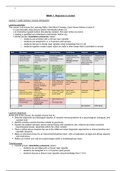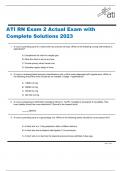WEEK 1: Diagnosis in context
Lecture 1 (video lecture): Course introduction
Learning activities
The course is structured by Learning Paths, that follow 5 themes. Each theme follows a track of:
a pre-recorded video lecture (watch individually before (2))
an interactive (guest) lecture (live plenary session, this year online via zoom)
reading a specified set of literature (individually, before (4))
tutorial groups (mandatory presence) where
o students are provided with a clinical case vignette
o students are assigned to 4- or 5-person peer groups
o students discuss a clinical case vignette using knowledge from (1)-(3)
o students together create a peer report (in-class or after class) that is submitted to canvas
Learning objectives
At the end of this course, the student knows how to:
Describe diagnostic and etiological aspects of complex mental problems at a psychological, biological, and
societal level.
Identify complex mental disorders related to psychosis.
Explain the relation between severe mental illness with substance use, violence and other comorbid
psychological issues, especially within the urban context.
Take a critical stance towards the use of the DSM and other diagnostic approaches in clinical practice and
scientific research.
Make an informed choice for an intervention/treatment plan, with consideration of legal and ethical aspects
and restrictions.
Reflect on his/her own role as a psychologist within a multidisciplinary team.
Tutorial groups
Tutorial groups (mandatory presence) where
o students are provided with a clinical case vignette
o students are assigned to 4- or 5-person peer groups
o students discuss a clinical case vignette using knowledge from (1)-(3)
, 2
o students together create a peer report (in-class or after class) that is submitted to canvas
Substitute Task: In case of absence, students have to arrange a new group meeting with other absent
students themselves. The group meeting has to be videotaped and the peer report has to be handed in
before the regular deadline in order to pass to course.
Group assignments (pass/fail)
Peer assignments
We use the tool Miro Mindmapping
We have to arrange a mindmap and save this as a PDF. You can arrange your discussion e.g. positive and
negative aspects. Make sure to create a legenda if you do this!
Names of the group members have to be visible!
Evaluation
Three pass/fail assignments
Exam:
o December 11th. 2020 from 13:30 – 16:00
o M-hall / online proctoring
o Open questions see tutorial on questions
How do you argument your statements?
How do you reflect on what you say?
o 100% of grade
General
Use the discussion forum for:
o Questions, queries, discussions
o In case of substitute task: find team members
Recording of interactive lectures
o Zoom lectures will be recorded
o You are allowed to close your video
Interaction during lectures
o Use the chat for real-time questions
o Use the discussion forum
Lecture 2 (interactive lecture): Diagnosis in context
Severe and Persistent Mental Illness (SPMI)
The National Institute of Mental Health (1987) defined SPMI using the following criteria:
o A major diagnosis of non-organic psychosis or personality disorder
o Duration of at least 2 years
o At least three of the five categories of functional disabilities
Diagnosis: a major affective, non-organic psychotic disorder (not due to brain damage for example) or a
disorder that may lead to a chronic disability such as borderline personality disorder
Duration: treatment history meets one or both of the following criteria
o Has undergone psychiatric treatment more intensive than outpatient care more than once in a
lifetime (e.g. crisis response services, alternative home care, partial hospitalization or inpatient
hospitalization)
o Has experiences an episode of continuous, supportive residential care, other than hospitalization,
for a longer period enough to have significantly disrupted the normal living situation.
Disability: severe recurrent disability resulting from mental illness. The disability results in functional
limitations in major life activities. Individuals must meet at least two of the following criteria on a continuing
or intermittent basis:
o Is unemployed, is employed in a sheltered setting or supportive work situation, or has markedly
limited skills and a poor work history
o Requires financial assistance from out-of-hospital maintenance and may be unable to procure such
assistance without help
o Has difficulty in establishing or maintaining a personal social support system
o Requires help in basic living skills such as hygiene, food preparation or money management
o Exhibits inappropriate social behavior which results in intervention by the mental and/or judicial
system
, 3
Disclaimer disability: this is the image when
we think about people with severe mental
illness, whom we sometimes don’t really
understand, etc. So this does not apply to
everyone! It’s good to keep this in mind, but
this image is not a necessity.
‘Difficult to treat patients’ or even ‘difficult
patients’
o Has a very clear appeal to stigma, but
these term is unfortunately used in
care
o A problematic aspect with patients
with severe mental illness is that
often more problems are occurring
than only mental illness. Sometimes
this makes it difficult to know who is
in charge or responsible when a lot of
institutes are involved.
o (Urban) contextual factors:
Poverty (dept)
Low social-economic status
Unemployment
Homelessness
Criminal / inappropriate social
behavior
o Dual diagnosis:
In combination with substance abuse (most often the case with this population. An
overlooked option is that substances are used as self-medication. This is important to take
into account, because these substances can be used as a coping method)
Childhood trauma, childhood abuse, and attachment problems
Depressive and anxiety symptoms. These may need to be treated, but have a complex
interaction with the most major diagnosis. This makes treatment more difficult
Perspective on SPMI: ‘For much of the 20th century, severe mental illness was considered chronic and
deteriorating, requiring institutional tertiary care or high-intensity secondary care. This approach changes in
the 1960s with the advent of antipsychotic drugs and subsequent deinstitutionalization, which gave new
hope to patients with severe mental illness who were discharged into the community’ (Whitley, Palmer, &
Gunn, 2015). So in the last few decades the climate of psychiatric care has changed drastically.
From care to cure
Cure is a word we know from the medical (physical) healthcare. It’s an ideal that is very much rooted as well
in psychiatric care. The term severe mental illness implies the medical discourse of cure and a drug-
based treatment. This cure paradigm, regardless of the symptom severity, that implies that people can be
cured.
Nomothetic approach: explanation of symptoms by underlying disease. Nomothetic is an universal
approach which hold to certain laws or regulations that apply for everyone, so it’s the opposite of an
personalized approach.
o In psychiatry as well as in the medical world the focus is often on universal / lawful disease states.
o When person X has disease Y, the disease will cause symptoms x, y and z. This is a general
assumption in the general model.
o In psychiatry we like to infer such underlying disease states, but it’s very difficult to know the
underlying disease states. What’s known are the symptoms.




